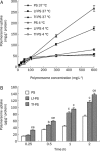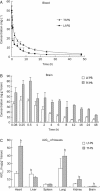Effect of lactoferrin- and transferrin-conjugated polymersomes in brain targeting: in vitro and in vivo evaluations
- PMID: 20139907
- PMCID: PMC4002844
- DOI: 10.1038/aps.2009.199
Effect of lactoferrin- and transferrin-conjugated polymersomes in brain targeting: in vitro and in vivo evaluations
Abstract
Aim: To evaluate the effect of lactoferrin (Lf) and transferrin (Tf) in brain targeting.
Methods: Polymersomes (PSs), employed as vectors, were conjugated with Lf or Tf and were characterized by morphology, particle size, zeta potential, and surface densities of the Lf or Tf molecules. In vitro uptake of Lf-PS and Tf-PS by bEnd.3 cells was investigated using coumarin-6 as a fluorescent probe. In vivo tissue distribution and pharmacokinetics of (125)I-Lf-PS and (125)I-Tf-PS were also examined.
Results: The mean particle size of PS, Lf-PS, and Tf-PS was around 150 nm and the zeta potential of the PSs was about -20 mV. Less than 0.12% of the coumarin was released from coumarin-6-loaded PS in 84 h indicating that coumarin-6 was an accurate probe for the PSs' behavior in vitro. It was shown that the uptake of Lf-PS and Tf-PS by bEnd.3 cells was time-, temperature-, and concentration-dependent. Both Lf and Tf could increase the cell uptake of PSs at 37 degrees C, but the uptake of Tf-PS was significantly greater than that of Lf-PS. In vivo tissue distribution and pharmacokinetics in mice revealed higher brain uptake and distribution of Tf-PS than Lf-PS, which was in accordance with in vitro uptake results. The drug targeting index (DTI) of Tf-PS with regard to Lf-PS was 1.51.
Conclusion: Using a PS as the delivery vector and bEnd.3 cells as the model of the blood-brain barrier (BBB), Tf was more effective than Lf in brain targeting.
Figures





Similar articles
-
Pharmacokinetics and brain uptake of lactoferrin in rats.Life Sci. 2006 Jan 18;78(8):851-5. doi: 10.1016/j.lfs.2005.05.085. Epub 2005 Sep 13. Life Sci. 2006. PMID: 16165165
-
Self-assembled polymersomes conjugated with lactoferrin as novel drug carrier for brain delivery.Pharm Res. 2012 Jan;29(1):83-96. doi: 10.1007/s11095-011-0513-7. Epub 2011 Oct 7. Pharm Res. 2012. PMID: 21979908
-
A novel lactoferrin-modified β-cyclodextrin nanocarrier for brain-targeting drug delivery.Int J Pharm. 2013 Dec 15;458(1):110-7. doi: 10.1016/j.ijpharm.2013.10.005. Epub 2013 Oct 12. Int J Pharm. 2013. PMID: 24126038
-
Lactoferrin coated or conjugated nanomaterials as an active targeting approach in nanomedicine.Int J Biol Macromol. 2021 Jan 15;167:1527-1543. doi: 10.1016/j.ijbiomac.2020.11.107. Epub 2020 Nov 17. Int J Biol Macromol. 2021. PMID: 33212102 Review.
-
Advancing Brain Targeting: Cost-Effective Surface-Modified Nanoparticles for Faster Market Entry.Pharmaceutics. 2025 May 17;17(5):661. doi: 10.3390/pharmaceutics17050661. Pharmaceutics. 2025. PMID: 40430951 Free PMC article. Review.
Cited by
-
Astaxanthin-loaded brain-permeable liposomes for Parkinson's disease treatment via antioxidant and anti-inflammatory responses.J Nanobiotechnology. 2025 Feb 4;23(1):78. doi: 10.1186/s12951-025-03104-8. J Nanobiotechnology. 2025. PMID: 39905399 Free PMC article.
-
Polymersome-based drug-delivery strategies for cancer therapeutics.Ther Deliv. 2015;6(4):521-34. doi: 10.4155/tde.14.125. Ther Deliv. 2015. PMID: 25996048 Free PMC article. Review.
-
Conjugation of functionalized SPIONs with transferrin for targeting and imaging brain glial tumors in rat model.PLoS One. 2012;7(5):e37376. doi: 10.1371/journal.pone.0037376. Epub 2012 May 17. PLoS One. 2012. PMID: 22615995 Free PMC article.
-
Advances in Targeted Drug Delivery Approaches for the Central Nervous System Tumors: The Inspiration of Nanobiotechnology.J Neuroimmune Pharmacol. 2017 Mar;12(1):84-98. doi: 10.1007/s11481-016-9698-1. Epub 2016 Jul 23. J Neuroimmune Pharmacol. 2017. PMID: 27449494 Review.
-
Physiological and Pathological Factors Affecting Drug Delivery to the Brain by Nanoparticles.Adv Sci (Weinh). 2021 Jun;8(11):e2002085. doi: 10.1002/advs.202002085. Epub 2021 Mar 15. Adv Sci (Weinh). 2021. PMID: 34105297 Free PMC article. Review.
References
-
- Pardridge WM. Blood-brain barrier delivery. Drug Discov Today. 2007;12:54–61. - PubMed
-
- Pardridge WM. Drug targeting to the brain. Pharm Res. 2007;24:1733–44. - PubMed
-
- Begley DJ. Delivery of therapeutic agents to the central nervous system: the problems and the possibilities. Pharmacol Ther. 2004;104:29–45. - PubMed
-
- Liu X, Chen C. Strategies to optimize brain penetration in drug discovery. Curr Opin Drug Disc. 2005;8:505–12. - PubMed
-
- Hu KL, Li JW, Shen YH, Lu W, Gao XL, Zhang QZ, et al. Lactoferrin-conjugated PEG-PLA nanoparticles with improved brain delivery: In vitro and in vivo evaluations. J Control Release. 2009;134:55–61. - PubMed
Publication types
MeSH terms
Substances
LinkOut - more resources
Full Text Sources
Miscellaneous

